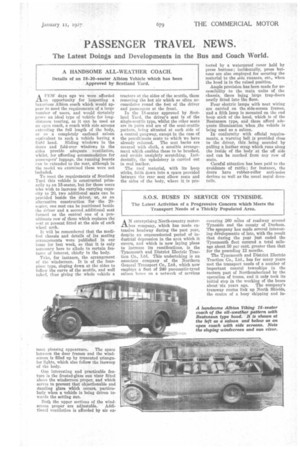PASSENGER TRAVEL NEWS.
Page 61

If you've noticed an error in this article please click here to report it so we can fix it.
The Latest Doings and Developments in the Bus and Coach World.
A HANDSOME ALL-WEATHER COACH.
Details of an 18-20-seater Albion Vehicle which has been Approved by Scotland Yard.
Zi A 1.1.11eV days ago we were afforded
on opportunity for inspecting a luxurious Albion coach which would appear to meet the requirements of a large number of users, and would 6ertainly prove an ideal type of vehicle for longdistance touring, as it can be used as an open coach, a coach with side screens extending the full length of the body, or os a completely enclosed saloon equivalent to such a vehicle having a fixad head. Sliding windows in the doors and fold-over windows in the sides provide adequate ventilation, whilst, for affording accommodation for passengers' luggage, the running boards can be extended to the rear, although in the model we examined these were not included. • To meet the requirements of Scotland Yard this vehicle is constructed primarily as an 18-seater, but for those users who wish to increase the carrying capacity to 20, two additional seats can be Provided beside the driver, or, as an alternative construction for the 20seater, one seat can be positioned beside the driver and a second .additional seat formed as the central one of a penultimate row of three which replaces the seat at present fitted at the side of each wheel arch.
It will be remembered that the modified chassis and detail's of its seating arrangements were published in our issue for last week, so that it is only necessary here to allude to certain features of interest, chiefly in the body.
Take, for instance, the arrangement of the windscreen. It is of the fourpiece type, sloping down at the sides to follow the curve of the scuttle, and well raked, thus giving the whole vehicle a most pleasing appearance. The space between the door frames and the windscreen is filled up by truncated triangular lights, which also follow the insweep of the body.
One interesting and practicable feature is the frosted-glass sun vizor fitted above the windscreen proper, and which serves to prevent that objectionable and dazzling glare which occurs, particularly when a vehicle is being driven towards the setting sun.
Both the upper sections of the wind
screen proper are adjustable. Additional ventilation is afforded by air ex tractors at the sides of the scuttle, these removing the hot air which so often accumulates round the feet of the driver and passengers at the front.
In the 1S-seater approved by Scotland Yard, the driver's seat is of the single-scuttle type, whilst the other seats are in pairs and are of the semi-scuttle pattern, being situated at each side of a central gangway, except in the case of the penultimate seats to which we have already referred. The seat backs are covered with cloth, a sensible arrangement which enables these to be brushed, and avoids unsightly scratching. Incidentally, the upholstery is carried out in real leather.
The roof material, with its hoop sticks, folds down into a space provided between the rear seat elbow rests and the sides of the body, where it is pro
tected by a waterproof cover held by press buttons ; incidentally, press buttons are also employed for securing the material to the side runners, etc., when the hood is in the raised position.
Ample provision has been made for accewibility to the main, units of the chassis, there being large trap-doors neatly fitted into the Boor.
Four electric lamps with neat wiring are carried on the side-screen frames, and a fifth lamp is mounted on the end hoop stick of the hood, which is of the lleatonson type, and these afford adequate illumination when the vehicle is being used as a saloon.
In conformity with official requirements, a warning bell is provided close to the driver, this being sounded by pulling a leather strap which runs along the inside of the body at the off side and can be reached from any row of seats.
Careful attention has been paid to the avoidance of rattle; for instance, the doors have rubber-roller anti-noise devices as well as the usual nnital dovetails,




































































































